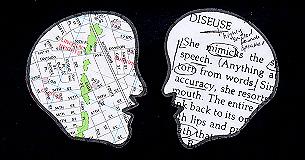navigating spaces
the
human
textual
body
body

navigating spaces |
 |
- Fredric Jameson Postmodernism |
- Trinh T. Minh-ha Woman, Native, Other |
Arriving from two distinct directions, the words of Trinh and Jameson evoke differing accounts of a contemporary postmodern aesthetic and its relation to the individual body, in regards both to the way in which each specific individual interacts with a continually shifting textual-narrative body and to the location of the physical human body in an external social space.
Before you sits the computer screen: its images, its text, its continuous visual offering of the possibility to exit (Back arrow) this specific location all work to construct a particular environment and a unique interaction between human body and textual-visual body. The virtual body of the World Wide Web provides one - and currently the most widespread - example of a textual, narrative, and social space through which we (explorers, browsers, readers, interactors) can navigate.
Through its own collection - a contextualized pastiche - of statements on contemporary theory relating to human and textual bodies in print and electronic spaces, this site invites you to map your own path through its virtual-textual body, a body which considers the following questions:
Where and how does the physical human body enter textual spaces, and in what ways does the human body itself become a text? Does a virtual environment offer the possibility of an alternative space in which to experiment with and reconstitute symbolically encoded constructs such as gender, or, in its current attention to surface representation and visual glitz does the Web merely present yet another manifestation of the alleged depthlessness and fragmentation of a postmodern identity, void of context? In what way does a symbolic map give meaning to a body of space, and how does the way in which words and images travel via spatial as opposed to temporal logic change the way in which we communicate? To what extent and in what ways do computer networks and electronic spaces reconfigure both the nature of the text and the relationship between textual body and human body?
We must also ask, ultimately and at the start, the implications of the distinct notions of Jameson and Trinh in regards to a contemporary postmodern social aesthetic, and consider whether electronic hyperspace leaves the individual human body, as Jameson claims, in a state of spatial and social confusion; or whether electronic spaces (and the Web in particular) instead facilitate the virtual embodiment of a fluid continuum "built on differences," and the ability to locate the constant shifting of the individual self through a medium that itself both relies upon and plays with the ever-present movement of the external world. Rather than transcending the capacities of the human body to locate itself, this "postmodern hyperspace" - both the external physical world and the virtual world of cyberspace - presents us with a story that has no fixed start or finish, that never stops beginning or ending, that varies according to the choices we make as we navigate our own individual paths. And it is precisely through the paths by which we choose to navigate that meaning continually emerges.
